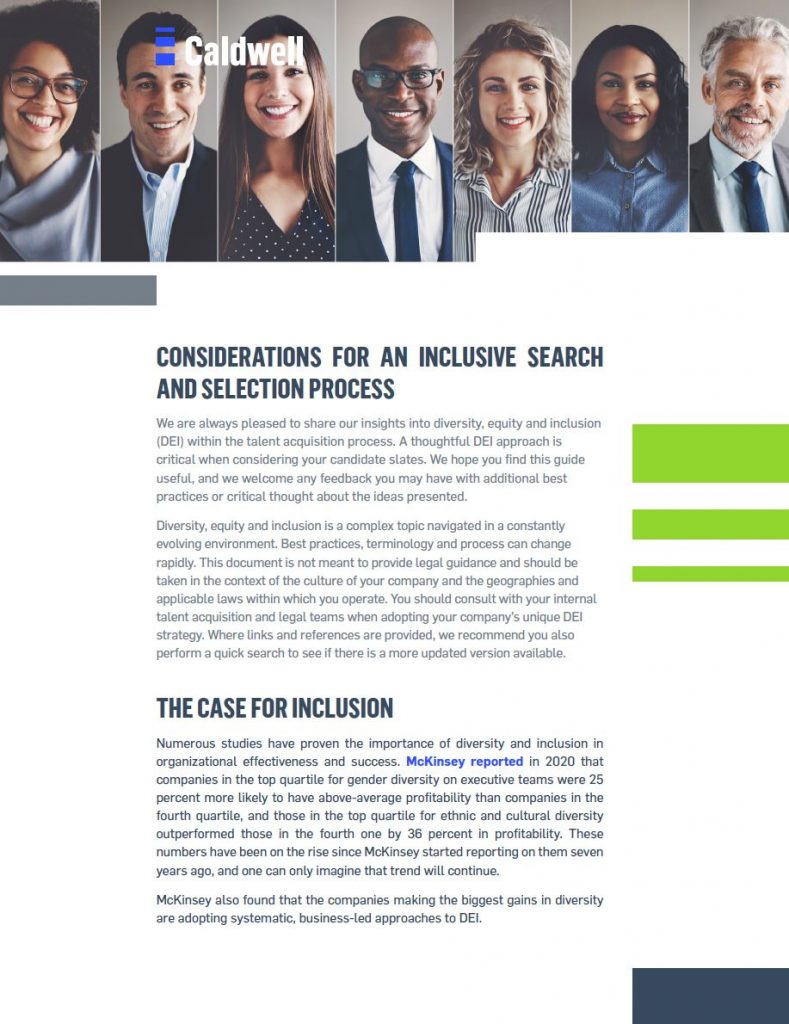The companies making the biggest gains in diversity are adopting systematic, business-led approaches to DEI and understand that it is more than ticking boxes to build a diverse slate of candidates. To ensure authenticity and inclusiveness in your organization’s DEI approach and search process, it is best to start before you even launch your search.
We compiled five inclusive hiring best practices to keep in mind for before you launch your search. For further guidance on ensuring an inclusive search and selection process, download our guide here.
Before You Launch Your Search
Get familiar with the terminology
If your organization is focused on building a more diverse and inclusive workforce, consider what you mean by these terms. You may wish to redress a gender imbalance in your team, or perhaps you want your candidate list to include people from one or more groups that have traditionally been underrepresented in employment. If you are successful in recruiting diverse candidates, what steps are you taking to ensure they feel welcomed and included in your environment?
There’s a lot of uncertainty about the right words to use when talking about diversity, equity and inclusion. Many people simply don’t talk about it because they’re worried they’ll say the wrong thing, but that is one of the biggest barriers holding organizations back from creating the conditions diverse teams need to thrive. Here are some DEI glossaries that might help you get more familiar with commonly used terms by region: Canada, the United States and the United Kingdom.
Articulate your definitions of diversity and inclusion
Ultimately, for diversity to make its most positive impact, we must seek a broad and inclusive slate of leaders for our clients with both inherent diversity (traits we are born with and/or are innate within our experience of the world) and acquired diversity (diversity derived from experience; for example, working in another country can help you appreciate cultural differences, while selling to female consumers can give you a better appreciation of gender differences).
Develop the job specification
Diversity of perspective is important throughout the search – including at the outset. You may wish to pull together a diverse, cross-functional team to consider the role, the mandate, and any unconscious biases that might enter into the development of the role profile or the assessment of candidates. Facilitate this discussion and invite all members of the team to contribute.
If you have a DEI expert in your organization, invite them to join the team.
Language Matters
When preparing the profile, avoid using gendered or binary terms, such as the universal “he” or “he or she.” Today, use of the word “they” – even when referring to just one person – is considered proper and inclusive.
Studies have shown that some words socially, culturally, and historically carry a stereotypical weight towards a particular gender. For example, use of the word “strong” can suggest that your organizational culture, or your hiring preference, is weighted towards one gender. Your cross-functional team, DEI expert, or HR leader can review the profile and remove gendered language.
You may wish to invite candidates to self-identify as members of underrepresented groups; your search consultant can help you manage that process.
You may wish to offer to provide accommodation for individuals who require it; a statement to that effect can be included in the role profile.
Key Criteria Evaluation Matrix
It’s good practice to synthesize the role profile into a one-page list of key criteria, with assigned weightings for each criterion. Your hiring team should discuss and agree upon this list. Later in the search, you can use the criteria list as a candidate evaluation matrix, to reduce bias in assessment by reviewing everyone against the same criteria.
Rather than assigning a numbered score for each criterion, you may wish to use an assessment rubric such as Exceeds, Meets, or Does not Meet Expectations, with an expanded definition of what is required to merit each of those assessments.
Learn what to keep in mind during the search process and examples of inclusive leadership interview questions and more in our inclusive search guide.
